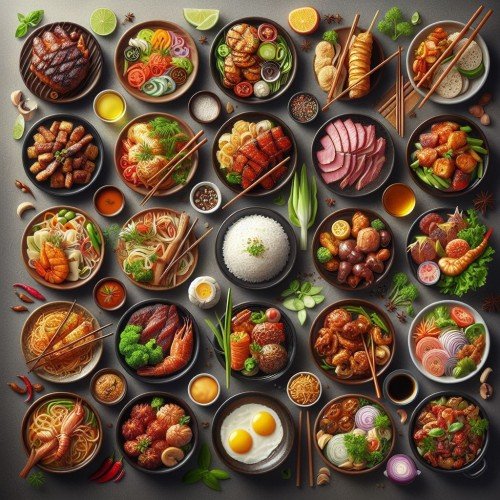The word “cuisine” originated from the French language. It is derived from the Old French word “cuisinier” which means “kitchen” or “cooking.” The term has been adopted into English during 18th century and is commonly used to refer to a style or method of cooking, especially as characteristic of a particular country, region, or establishment.

There are numerous types of cuisines around the world, each characterized by unique ingredients, cooking techniques, and flavors. Here are some of the prominent and diverse types of cuisines:
- Italian Cuisine: Known for pasta, pizza, olive oil, and a variety of regional dishes.
- French Cuisine: Emphasizes fresh, high-quality ingredients and elaborate preparation techniques.
- Mexican Cuisine: Famous for its vibrant colors, flavors, and dishes like tacos, enchiladas, and guacamole.
- Mediterranean Cuisine: Includes the traditional diets of countries bordering the Mediterranean Sea, such as Greek, Spanish, and Turkish cuisines.
- African Cuisine: Diverse and varied, with regional specialties from North Africa to Sub-Saharan Africa.
- Caribbean Cuisine: Influenced by African, Amerindian, European, and Asian culinary traditions.
- Brazilian Cuisine: Offers a mix of indigenous, African, and Portuguese influences.
- American Cuisine: Diverse due to the melting pot of cultures, with regional specialties such as Southern, Tex-Mex, and New England cuisine.
- Scandinavian Cuisine: Features fish, potatoes, and dairy products, with variations in Sweden, Norway, Denmark, Iceland, and Finland.
“Asian cuisine” is a broad and diverse term that encompasses the culinary traditions of the Asian continent. Asia is the largest and most populous continent, and as a result, its cuisine is incredibly varied, with distinct flavors, ingredients, and cooking styles found across different regions. Some of the major Asian cuisines include:
- Chinese Cuisine: Known for its diverse regional styles, Chinese cuisine features a wide range of flavors, ingredients, and cooking techniques. Popular dishes include stir-fries, dim sum, and various noodle and rice dishes.
- Japanese Cuisine: Emphasizes the use of fresh, seasonal ingredients and often includes dishes like sushi, sashimi, ramen, and tempura. Japanese cuisine places importance on the artful presentation of food.
- Indian Cuisine: Renowned for its rich and aromatic flavors, Indian cuisine varies widely by region. Common elements include the use of spices, herbs, lentils, and rice. Popular dishes include curry, biryani, and dosas.
- Thai Cuisine: Known for its balance of sweet, sour, salty, and spicy flavors, Thai cuisine features dishes like pad Thai, green curry, and tom yum soup. Fresh herbs and spices play a significant role.
- Korean Cuisine: Characterized by bold, spicy flavors and the use of fermented ingredients. Staple dishes include kimchi, bulgogi (marinated and grilled meat), and bibimbap.
- Vietnamese Cuisine: Features fresh herbs, rice noodles, and a balance of flavors. Pho (noodle soup), banh mi (sandwiches), and spring rolls are popular Vietnamese dishes.
- Indonesian Cuisine: Diverse and influenced by regional cultures, Indonesian cuisine often includes rice, noodles, satay, rendang, and a variety of flavorful sambals (chili pastes).
- Malaysian Cuisine: A fusion of Malay, Chinese, Indian, and indigenous influences. Dishes include nasi lemak, laksa, and satay.
- Filipino Cuisine: A blend of indigenous, Spanish, Chinese, and American influences. Adobo, sinigang, and lechon are well-known Filipino dishes.
- Middle Eastern Cuisine: Encompassing the culinary traditions of countries like Iran, Iraq, Israel, Lebanon, and others. Common elements include the use of olives, olive oil, grains, and spices.